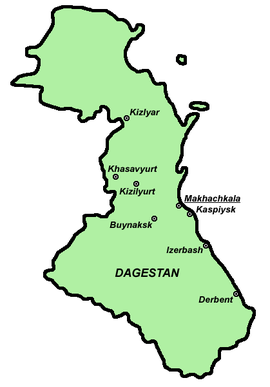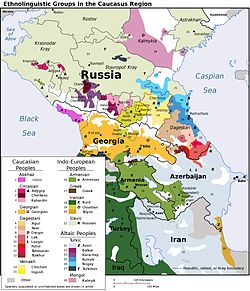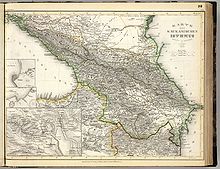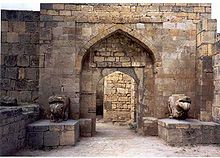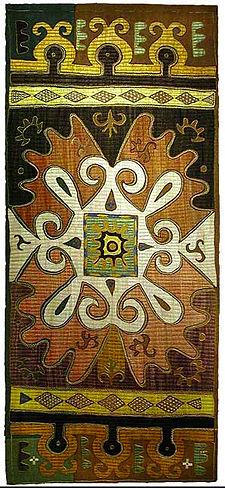- Dagestan
-
For other uses, see Dagestan (disambiguation).
Republic of Dagestan Республика Дагестан (Russian) — Republic — 
Flag
Coat of armsAnthem: National Anthem of the Republic of Dagestan Coordinates: 43°06′N 46°53′E / 43.1°N 46.883°ECoordinates: 43°06′N 46°53′E / 43.1°N 46.883°E Political status Country Russia Federal district North Caucasian[1] Economic region North Caucasus[2] Established January 20, 1921[3] Capital Makhachkala Government (as of August 2010) - President[4] Magomedsalam Magomedov[5] - Legislature People's Assembly[4] Statistics Area (as of the 2002 Census)[6] - Total 50,300 km2 (19,420.9 sq mi) Area rank 52nd Population (2010 Census)[7] - Total 2,977,419 - Rank 12th - Density 59.19 /km2 (153.3 /sq mi) - Urban 45.3% - Rural 54.7% Population (2002 Census)[8] - Total 2,576,531 - Rank 22nd - Density 51.22 /km2 (132.7 /sq mi) - Urban 42.8% - Rural 57.2% Time zone(s) MSD (UTC+04:00)[9] ISO 3166-2 RU-DA License plates 05 Official languages Russian;[10] Aghul, Avar, Azeri, Chechen, Dargwa, Kumyk, Lak, Lezgian, Nogai, Rutul, Tabasaran, Tat, Tsakhur[11][12] http://www.e-dag.ru/ The Republic of Dagestan (
 /dɑːɡɨˈstɑːn/ or /dæɡɨˈstæn/; Russian: Респу́блика Дагеста́н, Respublika Dagestan; also spelled Daghestan) is a federal subject (a republic) of Russia, located in the North Caucasus region. Its capital and the largest city is Makhachkala, located at the center of Dagestan on the Caspian Sea. Population: 2,977,419 (2010 Census preliminary results).[13]
/dɑːɡɨˈstɑːn/ or /dæɡɨˈstæn/; Russian: Респу́блика Дагеста́н, Respublika Dagestan; also spelled Daghestan) is a federal subject (a republic) of Russia, located in the North Caucasus region. Its capital and the largest city is Makhachkala, located at the center of Dagestan on the Caspian Sea. Population: 2,977,419 (2010 Census preliminary results).[13]Dagestan is ethnically very diverse, with several dozen ethnic groups and subgroups inhabiting the republic, most of which speak either Caucasian, Turkic, or Iranian languages. Largest among these ethnic groups are the Avar, Dargin, Kumyk, Lezgin, and Laks.[14] While Russians form only a small proportion (4.7%) of the population, Russian remains the primary official language.
Dagestan has been a scene of low-level Islamic insurgency, occasional outbreaks of separatism, ethnic tensions and terrorism since the 1990s. According to International Crisis Group, the militant Islamist organization Shariat Jamaat is responsible for much of the violence.[15] Much of the tension is rooted in an internal Islamic conflict between traditional Sufi groups advocating secular government and more recently introduced Salafist teachers preaching the implementation of Sharia law in Dagestan.
Contents
Toponymy
The word "Dagestan" has Turkic origin. Dag-means mountain, -stan- is Persian suffix which means land. The word Dagestan means "the land of mountains". Dagestan was known before as Albania, which also means "The land of Mountains". Географические названия мира: Топонимический словарь. — М: АСТ. Поспелов Е. М. 2001.
Names for Dagestan
Avar people name Dagestan - Дагъистаналъул Республика (Dağistanal‘ul Respublika), Dargins - Дагъистанес Республика (Dağistanes Respublika), Kumyks - Дагъыстан Республикасы (Dağıstan Respublikası), Lezgians - Дагъустандин Республика (Dağustandin Respublika), Laks - Дагъустаннал Республика (Dağustannal Respublika), Tabasarans - Дагъустан Республика (Dağustan Respublika), Turkish - Dağıstan Cumhuriyeti, Azerbaijanis - Dağıstan Respublikası, Chechens - Dexasta-çö.
Geography
The republic is situated in the North Caucasus mountains. It is the southernmost part of Russia, and is bordered on its eastern side by the Caspian Sea.
- Area: 50,300 square kilometers (19,400 sq mi)
- Borders:
- internal: Republic of Kalmykia (N), Chechen Republic (W), and Stavropol Krai (NW)
- international: Azerbaijan (S), Georgia (SW)
- water: Caspian Sea (E)
- Highest point: Bazardyuzi Mountain (4,466 m)
- Maximum north-south distance: 400 kilometers (250 mi)
- Maximum east-west distance: 200 kilometers (120 mi)
Rivers
There are over 1,800 rivers in the republic. Major rivers include:
- Sulak River
- Samur River
- Terek River
- Rubas River
- Avar Koisu
Lakes
Dagestan has about 400 kilometers (250 mi) of coast line on the Caspian Sea.
Mountains
Most of the Republic is mountainous, with the Greater Caucasus Mountains covering the south. The highest point is the Bazardyuzi peak at 4,466 m.
Natural resources
Dagestan is rich in oil, natural gas, coal, and many other minerals.
Climate
The climate is hot and dry in the summer but the winters are hard in the mountain areas.
- Average January temperature: 2 °C (36 °F)
- Average July temperature: 26 °C (79 °F)
- Average annual precipitation: 250 (northern plains) to 800 mm (in the mountains).
Administrative divisions
Main article: Administrative divisions of DagestanDemographics
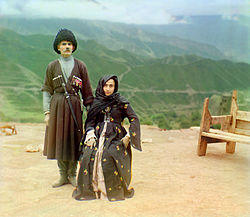 A couple in traditional dress poses for a portrait in Dagestan. Photographed by Sergey Prokudin-Gorsky, circa 1907 to 1915.
A couple in traditional dress poses for a portrait in Dagestan. Photographed by Sergey Prokudin-Gorsky, circa 1907 to 1915.
Because its mountainous terrain impedes travel and communication, Dagestan is unusually ethnically diverse, and still largely tribal. It is Russia's most heterogeneous republic. Unlike most other parts of Russia, Dagestan's population is rapidly growing.[16]
- Population: 2,576,531 (2002)
- Urban: 1,102,577 (42.8%)
- Rural: 1,473,954 (57.2%)
- Male: 1,242,437 (48.2%)
- Female: 1,334,094 (51.8%)
- Females per 1000 males: 1,074
- Average age: 25.2 years
- Urban: 25.1 years
- Rural: 25.2 years
- Male: 24.0 years
- Female: 26.3 years
- Number of households: 570,036 (with 2,559,499 people)
- Urban: 239,338 (with 1,088,814 people)
- Rural: 330,698 (with 1,470,685 people)
- Vital statistics
- Source: Russian Federal State Statistics Service
Births Deaths Birth rate Death rate 1970 41,381 9,543 28.8 6.6 1975 42,098 10,292 27.3 6.7 1980 44,088 11,188 26.6 6.8 1985 50,053 12,010 28.7 6.9 1990 48,209 11,482 26.1 6.2 1991 47,461 12,062 24.9 6.3 1992 44,986 12,984 22.9 6.6 1993 41,863 14,777 20.8 7.3 1994 44,472 15,253 21.0 7.2 1995 45,680 15,700 20.7 7.1 1996 42,282 15,565 18.8 6.9 1997 41,225 15,662 17.9 6.8 1998 41,164 15,793 17.4 6.7 1999 38,281 16,020 15.8 6.6 2000 38,229 16,108 15.5 6.5 2001 38,480 15,293 15.3 6.1 2002 41,204 15,887 16.1 6.2 2003 41,490 15,929 16.0 6.1 2004 41,573 15,724 15.9 6.0 2005 40,814 15,585 15.5 5.9 2006 40,646 15,939 15.3 6.0 2007 45,470 15,357 17.0 5.7 2008 49,465 15,794 18.3 5.9 Ethnic groups
The people of Dagestan include a large variety of ethnic groups. According to the 2002 Census, Northeast Caucasians (including Avars, Dargins, Tabasarans and Lezgins) make up almost 75% of the population of Dagestan. Turkic peoples, Kumyks, Nogais and Azeris make up 19%, and Russians 4% . Other ethnic groups each account for less than 0.5% of the total population.
It should be noted that such groups as the Botlikh, the Andi, the Akhvakhs, the Tsez and about ten other groups were reclassified as Avars between the 1926 and 1939 censuses.[17]
census 1926 census 1939 census 1959 census 1970 census 1979 census 1989 census 2002 Avars 177,189 (22.5%) 230,488 (24.8%) 239,373 (22.5%) 349,304 (24.5%) 418,634 (25.7%) 496,077 (27.5%) 758,438 (29.4%) Dargins 125,707 (16.0%) 150,421 (16.2%) 148,194 (13.9%) 207,776 (14.5%) 246,854 (15.2%) 280,431 (15.6%) 425,526 (16.5%) Kumyks 87,960 (11.2%) 100,053 (10.8%) 120,859 (11.4%) 169,019 (11.8%) 202,297 (12.4%) 231,805 (12.9%) 365,804 (14.2%) Lezgins 90,509 (11.5%) 96,723 (10.4%) 108,615 (10.2%) 162,721 (11.4%) 188,804 (11.6%) 204,370 (11.3%) 336,698 (13.1%) Laks 39,878 (5.1%) 51,671 (5.6%) 53,451 (5.0%) 72,240 (5.1%) 83,457 (5.1%) 91,682 (5.1%) 139,732 (5.4%) Tabasarans 31,915 (4.0%) 33,432 (3.6%) 33,548 (3.2%) 53,253 (3.7%) 71,722 (4.4%) 78,196 (4.6%) 111,152 (4.3%) Nogais 26,086 (3.3%) 4,677 (0.5%) 14,939 (1.4%) 21,750 (1.5%) 24,977 (1.5%) 28,294 (1.6%) 38,168 (1.5%) Rutuls 10,333 (1.3%) 20,408 (2.2%) 6,566 (0.6%) 11,799 (0.8%) 14,288 (0.9%) 14,955 (0.8%) 24,298 (0.9%) Aguls 7,653 (1.0%) 6,378 (0.6%) 8,644 (0.6%) 11,459 (0.7%) 13,791 (0.8%) 23,314 (0.9%) Tsakhurs 3,531 (0.4%) 4,278 (0.4%) 4,309 (0.3%) 4,560 (0.3%) 5,194 (0.3%) 8,168 (0.3%) Russians 98,197 (12.5%) 132,952 (14.3%) 213,754 (20.1%) 209,570 (14.7%) 189,474 (11.6%) 165,940 (9.2%) 110,875 (4.7%) Azeris 23,428 (3.0%) 31,141 (3.3%) 38,224 (3.6%) 54,403 (3.8%) 64,514 (4.0%) 75,463 (4.2%) 111,656 (4.3%) Chechens 21,851 (2.8%) 26,419 (2.8%) 12,798 (1.2%) 39,965 (2.8%) 49,227 (3.0%) 57,877 (3.2%) 87,867 (3.4%) Others 43,861 (5.6%) 52,031 (5.6%) 61,495 (5.8%) 63,787 (4.5%) 57,892 (3.6%) 58,113 (3.2%) 25,835 (1.0%) The indigenous ethnic groups of Dagestan are bolded.
There are also forty or so tiny groups such as the Hinukh, numbering 200, or the Akhvakhs, who are members of a complex family of indigenous Caucasians. Notable are also the Hunzib or Khunzal people who live in only four towns in the interior.
Over thirty local languages are commonly spoken, most belonging to the North-East Caucasian language family. The lingua franca in Dagestan is Russian[citation needed].
Economy
File:Makhachkala railway station.jpgMakhachkala railway stationThe major industries in Dagestan include oil production, engineering, chemicals, machine building, textile manufacturing, food processing, and the timber. Oil deposits are located in the narrow coastal region. The Dagestani oil is of high quality, and is delivered to other regions. Dagestan's natural gas production goes mostly to satisfy local needs. Agriculture is varied and includes grain-farming, viticulture and wine-making, sheep-farming, and dairying. The engineering and metalworking industries own 20% of the republic's industrial production assets and employ 25% of all industrial workers. Dagestan's hydroelectric power industry is developing rapidly. There are five power plants on the Sulak River providing hydroelectric power. It has been estimated that Dagestan's total potential hydroelectric power resources are 4.4 billion kW. Dagestan has a well-developed transportation system. Railways connect the capital Makhachkala to Moscow, Astrakhan, and the Azerbaijani capital, Baku. The Moscow-Baku highway also passes through Dagestan, and there are air links with major cities.[18][19]
Conditions for economic development are favorable in Dagestan, but – as of 2006 – the republic's low starting level for a successful transition to market relations, in addition to rampant corruption, has made the region highly dependent on its underground economy and the subsidies coming from the central Russian government.[19][20] Corruption in Dagestan is more severe than in other regions of the former Soviet Union, and is coupled with a flourishing black market and clan-based economic system.[15]
On 2011 Rostelecom started implementation of WDM-based equipment on the backbone network for data transmission in the Republic of Dagestan. Due to WDM introduction the fiber-optic communication lines bandwidth increased to 2.5 Gbps. Rostelecom invested about 48 million rubles in the project.[21]
Religion
Znamensky Cathedral in Khasavyurt
90.6% percent of Dagestan's population is Muslim, with Christians accounting for much of the remaining 9.4%.[22]
Dagestanis are largely Sunni Muslims, of the Shafii rites, that has been in place for centuries. On the Caspian coast, particularly in and around the port city of Derbent, the population (primarily made of the Azeris) is Shia.
A relatively large number of native Tati speaking Jews, designated by the Soviet state censuses as the "Mountain Jews" were also present in this same coastal areas, but since 1991 and the collapse of the Soviet Union they have migrated to Israel and the United States. These were an extension of much larger Jewish community across the border in Azerbaijan (districts of Quba and Shimakha).[23]
The appearance of Sufi mysticism in Dagestan dates back to the 14th century. The two Sufi tariqas that spread in the North Caucasus were the Naqshbandiya and the Qadiriya. The mystic Tariqas preached tolerance and coexistence between the diverse people in the region. In fact, from the middle of the 19th century, the national liberation movement against the Russian takeover was led by a Sufi/Tariqa leader, the famed Imam Shamil[24]. The Communist total intolerance for any religion after the Communist Revolution of 1917 also suppressed the Sufi movements. Shaykh Said Afandi al-Chirkawi is prominent scholar, spiritual leader and murshid of Naqshbandi and Shadhili tariqahs in Dagestan.[25]
After the Russian occupation of Dagestan from Persia in 1813 (see Russo-Persian Wars), and the gradual decline of native values in the region, Islam became a rallying point for all those who wished to preserve their native identity. Rasul Magomedov, a contemporary writer of Dagestan, writes about the unifying role of Islam:
- Before Islam, all Dagestani tribes were divided in respect of language, religion, ethnic structure and geography like all other Caucasian peoples. This situation caused severe hostility and conflicts. After all native tribes became Muslims, a unity in belief could be sustained among Dagestani tribes which also stopped ethnic conflicts among them. If these conflicts continued, our homeland would face great disasters. This unity could only be established by medressehs spread out all the country. The scientists, scholars, imams graduated from these medressehs had an important role in stopping these conflicts in this multinational region and they helped tribes to establish friendly relations. Islam should also serve such a goal today.[26]
The number of Christians among the non-Slavic indigenous population is very low, with estimates between 2,000 and 2,500. Most of these are Pentecostal Christians from the Lak ethnic group.[27][28] The largest congregation is Osanna Evangelical Christian Church (Pentecostal) in Makhachkala, with more than 1,000 members.[29]
History
The oldest records about the region refer to the state of Caucasian Albania in the south, with its capital at Derbent and other important centres at Chola, Toprakh Qala, and Urtseki. The northern parts were held by a confederation of Dagestani tribes. In the first few centuries AD, Caucasian Albania continued to rule over what is present day Azerbaijan and mountains of Dagestan. It was fought over in classical times by Rome and the Persian Sassanids and was early converted to Christianity.
In the 5th century AD, the Sassanids gained the upper hand and constructed a strong citadel at Derbent, known henceforward as the Caspian Gates, while the northern part of Dagestan was overrun by the Huns, followed by the Caucasian Avars. It is not clear whether the latter were instrumental in the rise of the Christian kingdom in the Central Dagestan highlands. Known as Sarir, this Avar-dominated state maintained a precarious existence in the shadow of Khazaria and the Caliphate until the 9th century, when it managed to assert its supremacy in the region.
In 664, the Persians were succeeded in Derbent by the Arabs who clashed with the Khazars. Although the local population rose against the Arabs of Derbent in 905 and 913, Islam was eventually adopted in urban centres, such as Samandar and Kubachi (Zerechgeran), from where it steadily penetrated into the highlands. By the 15th century, Albanian Christianity had died away, leaving a tenth-century church at Datuna as the sole monument to its existence.
Due to Muslim pressure and internal disunity, Sarir disintegrated in the early 12th century, giving way to the Khanate of Avaristan, a long-lived Muslim state that braved the devastating Mongol invasions of 1222 and 1239, followed by Tamerlane's raid in 1389.
As the Mongol authority gradually eroded, new centres of power emerged in Kaitagi and Tarki. In the sixteenth and 17th centuries, legal traditions were codified, mountainous communities (djamaats) obtained a considerable degree of autonomy, while the Kumyk potentates (shamhals) asked for the Tsar's protection. Russians intensified their hold in the region in the 18th century, when Peter the Great annexed maritime Dagestan in the course of the First Russo-Persian War. Although the territories were returned to Persia in 1735, the next bout of hostilities resulted in the Russian capture of Derbent in 1796.
The 18th century also saw the resurgence of the Khanate of Avaristan, which managed to repulse the attacks of Nadir Shah of Persia and impose tribute on Shirvan and Georgia. In 1803 the khanate voluntarily submitted to Russian authority, but it took Persia a decade to recognize all of Dagestan as the Russian possession (Treaty of Gulistan).
The Russian administration, however, disappointed and embittered the highlanders. The institution of heavy taxation, coupled with the expropriation of estates and the construction of fortresses (including Makhachkala), electrified highlanders into rising under the aegis of the Muslim Imamate of Dagestan, led by Ghazi Mohammed (1828–32), Gamzat-bek (1832–34) and Shamil (1834–59). This Caucasian War raged until 1864, when Shamil was captured and the Khanate of Avaristan was abolished.
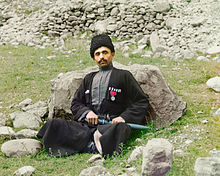 Dagestani man, photographed by Sergey Prokudin-Gorsky, circa 1907 to 1915
Dagestani man, photographed by Sergey Prokudin-Gorsky, circa 1907 to 1915
Dagestan and Chechnya profited from the Russo-Turkish War, 1877-1878, to rise together against Imperial Russia for the last time (Chechnya rose again various times throughout the late 19th and 20th centuries).
After the Bolshevik Revolution, Ottoman armies liberated Azerbaijan and Dagestan and the region became part of the short-lived Mountainous Republic of the Northern Caucasus. After more than three years of fighting White movement reactionaries and local nationalists, the Bolsheviks achieved victory and the Dagestan Autonomous Soviet Socialist Republic was proclaimed on 20 January 1921. Nevertheless, Stalin's industrialization largely bypassed Dagestan and the economy stagnated, making the republic the poorest region in Russia.
As with its neighbors Georgia, Azerbaijan and Chechnya, Dagestan developed a renewed nationalist movement in the late 1980s. Dagestani nationalism, however, rested on very unstable foundations, as the republic was (and is) extremely multiethnic, with many of its regions being recent additions, and even the existence of a unified Dagestan was relatively new with little historical context (previously, Avaria had been a separate entity, and most areas were completely unrelated to any sort of centralizing government). Dagestan's new elite, composed overwhelmingly of Avars, Dargins and Russians founded and consolidated its power. To this day, Dagestan is a very troubled region. There are various underground Wahhabist/Islamist movements (some more moderate than others, there was also a constitutional Islamizationist party before it was banned), originating as early as the late 80s.
Dagestan's poor population, often displeased with the "official" clergy (who they deem as government puppets, either of the Dagestani government or of Russia), is occasionally drawn to these groups as a form or reaction against the government (not in the least because of the unifying power of the common Muslim religion in a highly multiethnic area paired with the promises of the Islamists to "end inequality, patriarchalism and corruptions of the true faith" paired with their occasional assistance to poor communities). However, attraction to Islamism varies between sectors of the population. People from Southern Dagestan, poorer people, people with a lower education level and people from certain ethnic groups are more inclined to support Islamist tendencies.[citation needed] Whilst people from Northern Dagestan, Russians (who are not Muslim), Turkic peoples (who are often highly syncretic in their practice and often drawn instead to Turkic nationalism as a revolt against the authorities), more wealthy people, people from the hundred-or-so "governmental families", people with a higher education, and groups who are officially "not-native" to Dagestan (Russians, Azeris, Chechens, etc., regardless of actual nativeness they are not "titular groups") are less inclined.[citation needed] Separatism is also prominent: various groups resent the dominance of Dargins, Avars and Russians in government and revolt against this by calling Dagestan an artificial nation and demanding higher self-determination (i.e. secessionism). This is most noticeable among the Kumyks.[citation needed]
In 1999, a group of Muslim fundamentalists from Chechnya, led by warlords Shamil Basayev and Ibn Al-Khattab, launched a military invasion of Dagestan, with the aim of creating an "independent Islamic State of Dagestan". Although Basayev and Khattab had expected that they would be welcomed as liberators, the Dagestanis instead saw them as occupiers and unwelcome religious fanatics, and the initial resistance against the invasion was provided by the Dagestani police, spontaneous militias and villagers.[citation needed] Once Russian military help arrived, the invaders were beaten and driven back to Chechnya. As a retaliation, Russian forces subsequently reinvaded Chechnya later that year.[citation needed]
Dagestani conflict
Main article: Insurgency in the North CaucasusSince 2000, Dagestan has been the venue of a low-level guerilla war, bleeding over from Chechnya; the fighting has claimed the lives of hundreds of federal servicemen and officials – mostly members of local police forces – as well as many Dagestani national rebels and civilians.
More recently, among other incidents:
- On May 15, 2008, two MVD officers were killed and one police officer heavily wounded during an ambush on their vehicle in Gubden.
- On September 8, 2008, Abdul Madzhid and several rebels were killed in an ambush by Russian special forces.
- On October 21, 2008, rebels ambushed a Russian military truck, killing five troops and wounding nine others.
- On January 6, 2010, a suicide bomber attempted to blow up a police station in Makhachkala, killing six officers and wounding 14 others.
- On March 31, 2010, 12 people were killed and 18 wounded by two suicide bombings in the town of Kizlyar outside the offices of the local interior ministry and the FSB security agency. The second bomb went off twenty minutes after the first, as a crowd had gathered. In the early hours of the next morning two people died as a bomb went off in their car, apparently prematurely, near the village of Toturbiikala.
- On July 15, 2010, Pastor Artur Suleimanov, a Muslim convert to Christianity, was murdered by a gunman. The pastor was killed in his car as he was leaving the Hosanna House of Prayer in Makhachkala, Dagestan in the North Caucasus region, according to a religious persecution watchdog group, Voice of the Martyrs, report. Pastor Suleimanov's church is one of the largest Protestant churches in Dagestan. Christians in the Russian Republic of Dagestan, which borders Chechnya, face harassment and intimidation from various groups. Pastor Suleimanov's life had been threatened on several previous occasions.[30]
- On September 23, 2011, Magomed Murtuzaliyev, a high-level law enforcement official, was shot and killed by gunmen. [31]
- On September 28, 2011, 7 civilians and a police officer were killed by a car bomb in the village of Hajjalmakhi. [32]
Politics
The Parliament of Dagestan is the People's Assembly, consisting of 72 deputees elected for a four year term. The People's Assembly is the highest executive and legislative body of the republic.
The Constitution of Dagestan was adopted on July 10, 2003. According to it, the highest executive authority lies with the State Council, comprising representatives of fourteen ethnicities. The members of the State Council are appointed by the Constitutional Assembly of Dagestan for a term of four years. The State Council appoints the members of the Government.
The ethnicities represented in the State Council are Aguls, Avars, Azeris, Chechens, Dargins, Kumyks, Laks, Lezgins, Russians, Rutuls, Tabasarans, Tats, and Tsakhurs.
Formerly, the Chairman of the State Council was the highest executive post in the republic, held by Magomedali Magomedovich Magomedov until 2006. On February 20, 2006, the People's Assembly passed a resolution terminating this post and disbanding the State Council. Russian President Vladimir Putin offered the People's Assembly the candidature of Mukhu Aliyev for the newly established post of the President of Dagestan. The nomination was accepted by the People's Assembly, and Mukhu Aliyev became the first President of Dagestan.But today the President of Dagestan is Magomedsalam Magomedov(http://carnegie.ru/publications/?fa=40590)
See also
- Insurgency in the North Caucasus
- List of clashes in the North Caucasus
- Former countries in Europe after 1815
- Music of Dagestan
Notes
- ^ Президент Российской Федерации. Указ №849 от 13 мая 2000 г. «О полномочном представителе Президента Российской Федерации в федеральном округе». Вступил в силу 13 мая 2000 г. Опубликован: "Собрание законодательства РФ", №20, ст. 2112, 15 мая 2000 г. (President of the Russian Federation. Decree #849 of May 13, 2000 On the Plenipotentiary Representative of the President of the Russian Federation in a Federal District. Effective as of May 13, 2000).
- ^ Госстандарт Российской Федерации. №ОК 024-95 27 декабря 1995 г. «Общероссийский классификатор экономических регионов. 2. Экономические районы», в ред. Изменения №5/2001 ОКЭР. (Gosstandart of the Russian Federation. #OK 024-95 December 27, 1995 Russian Classification of Economic Regions. 2. Economic Regions, as amended by the Amendment #5/2001 OKER. ).
- ^ Всероссийский Центральный Исполнительный Комитет. Декрет от 20 января 1921 г. «Об Автономной Дагестанской Социалистической Советской Республике». (All-Russian Central Executive Committee. Decree of January 20, 1921 On Autonomous Dagestan Socialist Soviet Republic. ).
- ^ a b Constitution, Article 8
- ^ Lenta.ru. Новый президент Дагестана вступил в должность (Russian)
- ^ Федеральная служба государственной статистики (Federal State Statistics Service) (2004-05-21). "Территория, число районов, населённых пунктов и сельских администраций по субъектам Российской Федерации (Territory, Number of Districts, Inhabited Localities, and Rural Administration by Federal Subjects of the Russian Federation)" (in Russian). Всероссийская перепись населения 2002 года (All-Russia Population Census of 2002). Federal State Statistics Service. http://perepis2002.ru/ct/html/TOM_01_03.htm. Retrieved 2011-11-01.
- ^ Федеральная служба государственной статистики (Federal State Statistics Service) (2011). "Предварительные итоги Всероссийской переписи населения 2010 года (Preliminary results of the 2010 All-Russian Population Census)" (in Russian). Всероссийская перепись населения 2010 года (All-Russia Population Census of 2010). Federal State Statistics Service. http://www.perepis-2010.ru/results_of_the_census/results-inform.php. Retrieved 2011-04-25.
- ^ Федеральная служба государственной статистики (Federal State Statistics Service) (2004-05-21). "Численность населения России, субъектов Российской Федерации в составе федеральных округов, районов, городских поселений, сельских населённых пунктов – районных центров и сельских населённых пунктов с населением 3 тысячи и более человек (Population of Russia, its federal districts, federal subjects, districts, urban localities, rural localities—administrative centers, and rural localities with population of over 3,000)" (in Russian). Всероссийская перепись населения 2002 года (All-Russia Population Census of 2002). Federal State Statistics Service. http://www.perepis2002.ru/ct/doc/1_TOM_01_04.xls. Retrieved 2010-03-23.
- ^ Правительство Российской Федерации. Постановление №725 от 31 августа 2011 г. «О составе территорий, образующих каждую часовую зону, и порядке исчисления времени в часовых зонах, а также о признании утратившими силу отдельных Постановлений Правительства Российской Федерации». Вступил в силу по истечении 7 дней после дня официального опубликования. Опубликован: "Российская Газета", №197, 6 сентября 2011 г. (Government of the Russian Federation. Resolution #725 of August 31, 2011 On the Composition of the Territories Included into Each Time Zone and on the Procedures of Timekeeping in the Time Zones, as Well as on Abrogation of Several Resolutions of the Government of the Russian Federation. Effective as of after 7 days following the day of the official publication).
- ^ Official the whole territory of Russia according to Article 68.1 of the Constitution of Russia.
- ^ According to Article 11 of the Constitution of Dagestan, the official languages of the republic include "Russian and the languages of the peoples of Dagestan"
- ^ Solntsev, pp. XXXIX–XL
- ^ Федеральная служба государственной статистики (Federal State Statistics Service) (2011). "Предварительные итоги Всероссийской переписи населения 2010 года (Preliminary results of the 2010 All-Russian Population Census)" (in Russian). Всероссийская перепись населения 2010 года (All-Russia Population Census of 2010). Federal State Statistics Service. http://www.perepis-2010.ru/results_of_the_census/results-inform.php. Retrieved 2011-04-25.
- ^ Dagestan. Encyclopædia Britannica (Online edition)
- ^ a b Russia’s Dagestan: Conflict Causes. International Crisis Group Europe Report N°192. 3 June 2008
- ^ Ware, Robert Bruce. Islamic Resistance and Political Hegemony in Dagestan
- ^ Wixman, Ronald. The Peoples of the USSR: An Ethnographic Handbook. (Armonk, New York: M. E. Sharpe, Inc, 1984) p. 11
- ^ Dagestan Microsoft Encarta Online Encyclopedia 2008. Archived 2009-10-31.
- ^ a b Dagestan Republic Kommersant 2004-03-10
- ^ Dagestan’s Economic Crisis: Past, Present and Future North Caucasus Weekly 2006-12-31
- ^ Broadband Russia Newslatter
- ^ http://www.rferl.org/section/North+Caucasus/167.html
- ^ Mountain Jews at World Culture Encyclopedia
- ^ The Great Shamil, Imam of Dagestan and Chechnya, Shaykh of Naqshbandi tariqah
- ^ Biography of Shaykh Said Afandi al-Chirkawi
- ^ Religion in Dagestan
- ^ http://www.sclj.org/news/10-0729-PastorSuleymanov.htm
- ^ http://www.jstor.org/pss/4030847
- ^ http://www.sclj.ru/news/detail.php?ID=2956
- ^ https://www.be-a-voice.net/qrs/bv_page.taf?_function=bltn&_id=150&_nc=738ce2e2893d729464ae2bf683413678
- ^ http://www.nytimes.com/2011/09/24/world/europe/russia-official-killed-in-dagestan.html?scp=2&sq=dagestan&st=cse
- ^ http://www.nytimes.com/reuters/2011/09/28/world/europe/international-us-russia-dagestan-bomb.html?hp
References
- В. М. Солнцев и др., ed (2000) (in Russian). Письменные языки мира: Российская Федерация. Социолингвистическая энциклопедия.. Москва: Российская Академия Наук. Институт языкознания.. p. 651. проект №99-04-16158.
- 10 июля 2003 г. «Конституция Республики Дагестан», в ред. Закона №45 от 7 октября 2008 г. (July 10, 2003 Constitution of the Republic of Dagestan, as amended by the Law #45 of October 7, 2008. ).
External links
- (Russian) Official governmental website of Dagestan
- History of Islam in Russia
- "The North Caucasus," Russian Analytical Digest No. 22 (5 June 2007)
- BBC Country Report on Dagestan
- University of Texas maps of the Dagestan region
- Radio Free Europe discusses religious tension in Dagestan
- ISN Case Study: The North Caucasus on the Brink (August 2006)
- Articles on Dagestan, reports from research, photos
- Dagestan in Pictures (Russian)
- Daghestan's Kaitag Embroideries - and Henri Matisse?
- (Russian) Dagestan Republic News Portal
Further reading
- Kaziev, Shapi. Imam Shamil. "Molodaya Gvardiya" publishers. Moscow, 2001, 2003, 2006, 2010
- Kaziev, Shapi. Akhoulgo. Caucasian War of XIX-th century. The historical novel. "Epoch", Publishing house. Makhachkala, 2008. ISBN 978-5-98390-047-9
- Kaziev, Shapi. Caucasian highlanders. Everyday life of the Caucasian highlanders. 19-th century (In the co-authorship with I.Karpeev). "Molodaya Gvardiy" publishers. Moscow, 2003. ISBN 5-235-02585-7
- Kaziev, Shapi. Crash of tyrant. Nadir Shah (Крах тирана). The historical novel about Nadir Shah. "Epoch", Publishing house. Makhachkala, 2009. ISBN 978-5-98390-066-0
Subdivisions of Russia Republics Krais Oblasts - Amur
- Arkhangelsk
- Astrakhan
- Belgorod
- Bryansk
- Chelyabinsk
- Irkutsk
- Ivanovo
- Kaliningrad
- Kaluga
- Kemerovo
- Kirov
- Kostroma
- Kurgan
- Kursk
- Leningrad
- Lipetsk
- Magadan
- Moscow
- Murmansk
- Nizhny Novgorod
- Novgorod
- Novosibirsk
- Omsk
- Orenburg
- Oryol
- Penza
- Pskov
- Rostov
- Ryazan
- Sakhalin
- Samara
- Saratov
- Smolensk
- Sverdlovsk
- Tambov
- Tomsk
- Tula
- Tver
- Tyumen
- Ulyanovsk
- Vladimir
- Volgograd
- Vologda
- Voronezh
- Yaroslavl
Federal cities Autonomous oblasts Autonomous okrugs 1administratively subordinated to Tyumen Oblast 2 administratively subordinated to Arkhangelsk Oblast
Countries and regions of the Caucasus History of Europe Prehistoric Europe Classical Antiquity Classical Greece · Roman Republic · Hellenistic period · Roman Empire · Late Antiquity · Early Christianity · Crisis of the 3rd century · Fall of the Roman EmpireMiddle Ages Early Middle Ages · Migration Period · Byzantine Empire · Christianization · Kievan Rus · High Middle Ages · Holy Roman Empire · Crusades · Feudalism · Late Middle Ages · Hundred Years' War · RenaissanceEarly Modern Europe Reformation · Age of Discovery · Baroque · Thirty Years' War · Absolutism · Ottoman Empire · Portuguese Empire · Spanish Empire · Early modern France · Polish–Lithuanian Commonwealth · Swedish Empire · Dutch Republic · British Empire · Habsburg Empire · Russian EmpireModern history See also Politics of Europe Sovereign
states- Albania
- Andorra
- Armenia
- Austria
- Azerbaijan
- Belarus
- Belgium
- Bosnia and Herzegovina
- Bulgaria
- Croatia
- Cyprus
- Czech Republic
- Denmark
- Estonia
- Finland
- France
- Georgia
- Germany
- Greece
- Hungary
- Iceland
- Ireland
- Italy
- Kazakhstan
- Latvia
- Liechtenstein
- Lithuania
- Luxembourg
- Macedonia
- Malta
- Moldova
- Monaco
- Montenegro
- Netherlands
- Norway
- Poland
- Portugal
- Romania
- Russia
- San Marino
- Serbia
- Slovakia
- Slovenia
- Spain
- Sweden
- Switzerland
- Turkey
- Ukraine
- United Kingdom
- (England
- Northern Ireland
- Scotland
- Wales)
- Vatican City
States with limited
recognition- Abkhazia
- Kosovo
- Nagorno-Karabakh
- Northern Cyprus
- South Ossetia
- Transnistria
Dependencies
and other territories- Åland
- Faroe Islands
- Gibraltar
- Guernsey
- Jan Mayen
- Jersey
- Isle of Man
- Svalbard
Other entities - European Union
Categories:- Dagestan
- States and territories established in 1921
Wikimedia Foundation. 2010.


